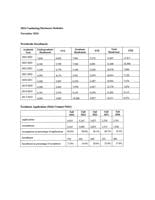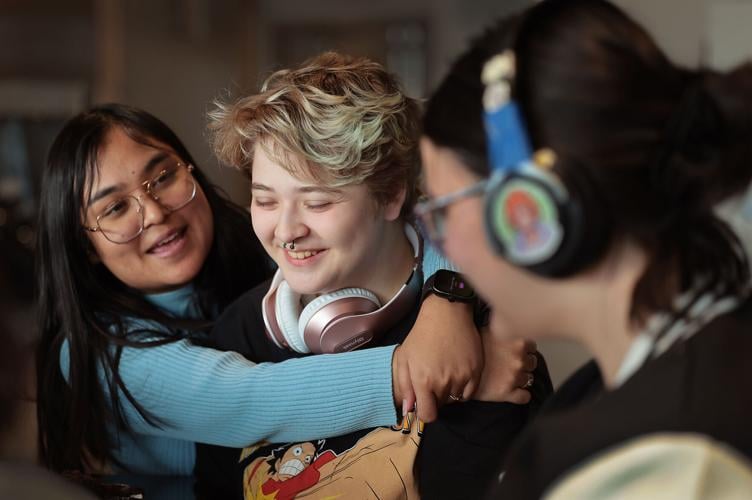
Pranistha Upadhyaya, left, a freshman from Nepal studying biological science, joins Samantha Reeves, a graphic design freshman, and Tessa Holt, an illustration freshman, as they have lunch together at Webster University on Friday, Jan. 24, 2025.
WEBSTER GROVES — After nearly 10 years of deficits, Webster University officials said they’re seeing signs the university could break even or end the current fiscal year with a surplus.
University leaders credited what they described as a “turnaround” to strategic planning and significant enrollment increases after the private university’s enrollment declined for years.
While Webster’s worldwide enrollment has indeed increased — 15,037 students currently compared to 13,484 in the prior academic year — Webster also accepted nearly every freshman who applied to attend its main campus.
Webster accepted 96% of freshmen seeking to attend the university at its Webster Groves headquarters this fall, a jump from 59% reported acceptance the previous year, according to a report Webster submitted to bondholders this month.
People are also reading…
Audited financial statements show Maryville University also upped its acceptance of freshmen applicants in recent years, going from a rate of about 88% acceptance in fall 2022, then 93% in fall 2023 and 95% this academic year.
51���� University has become less selective in recent years, accepting 75% of freshmen applicants for the current school year compared to 56% in 2020-21.
Webster welcomed 576 freshmen at its main campus this fall, the largest class of first-time freshmen at the Webster Groves campus in the past five years. The university had 443 freshmen enrolled there the prior academic year.
The increase not only reflects Webster’s attempt to increase its enrollments and bolster its finances, but larger trends in higher education.
Higher education institutions are competing for a dwindling number of students as birth rates decline — a problem compounded by shifting views on the value of a college degree. And college-aged students have increasingly opted for certificate programs or technical training in lieu of four-year degrees, with enrollment in that sector rapidly exceeding any undergraduate gains since the pandemic, the .
In the meantime, some colleges have made it easier to get in. Nationwide, the median acceptance rate at institutions that offer bachelor’s degrees or higher has risen 1.4 percentage points since 2002, and 7.6 percentage points since 2012, the lowest year for admissions in the past two decades, according to an analysis by the .
Competition is steep. But while Webster’s numbers climb, university leaders say there’s more to the story.

Jeffrey R. Carter, professor of music at Webster University, gives a voice lesson to freshman Michael Stark, a music theater major from Sacramento, Calif., on Friday, Jan. 24, 2025.
Same standards
The reported 37-point rise in Webster’s acceptance rate is not a result of the university lowering its standards, said Patrick Giblin, director of public relations for the university.
The U.S. Department of Education they should only report applications that prospective students fully completed. Before that, Webster reported both complete and incomplete applications, such as those submitted through streamlined admissions services like the that can lack key elements including final transcripts, Giblin said.
Webster didn’t implement the revised guidelines until 2024, which made it seem as if the university turned down more applicants in previous years, when really some never finished and were therefore unacceptable, Giblin said.
And at the same time, the university started to see an influx of international students who were conditionally accepted until they could submit visa approvals and medical records. Their incomplete applications created a skew, Giblin said.
“We are correcting data from previous years and will resubmit that to the reporting agencies to ensure more consistency in what is publicly available,” Giblin said.
But even with the change taken into account, Webster’s share of accepted freshmen applications at its main campus still went up from the prior academic year to the current, from 91% to 96%.
Freshmen admissions at Webster’s home campus represent only a small slice of Webster’s student population.
Giblin declined to provide data on the acceptance of other students, such as transfers or graduates, which Webster is not required to report. He described such information as “protected proprietary information” that the university would not share “as it would give our competitors an advantage in recruitment strategies.”
The share of accepted applicants who actually decided to enroll at Webster, 13%, was this year the lowest the university had seen since at least fall 2020.
‘Effective recruiting’
This fall, Webster reported nearly a thousand more freshmen applications than the past five enrollment cycles on average. That’s despite the federal reporting change that Giblin said required the university to report only completed applications.
Giblin attributed the rise in applications to “effective recruiting programs.”
Webster officials have international students enrolled at its U.S. campuses comprised the largest population growths.
International freshmen enrollment nearly quadrupled over the last two falls, from 71 to 277 students, according to preliminary enrollment figures Webster shared with the Post-Dispatch in October.
Auditors in their latest report on Webster wrote the university built a robust network of international recruiting agencies, leading to an increase of $24 million in net tuition revenue over the last two years.
Lisa Blazer, vice president of enrollment management at Webster, said the university ramped up international recruitment after the pandemic in anticipation of the so-called “enrollment cliff” caused by a decrease in birth rates after the 2008 recession.
“If you’re looking at how you can increase enrollment, you can’t rely just on the traditional freshmen population,” Blazer said.
Webster saw strong recruitment from India and Nepal this year, Blazer said.
The university also doubled down on advertising over the past two years, going from spending $8 million in 2023 to $14 million in 2024.
The most recent admission figures indicate freshmen had lower high school grades than Webster has historically accepted, with about 31% of freshmen scoring in the top 25% of their class compared to 49% in fall 2023. About 7% fewer students were in the top 10% of their class.
Giblin said the class rank statistic doesn’t indicate much, since fewer high schools still report class rank, and few higher education institutions still require it for admission. He pointed to how Webster freshmen have had the same average ACT score of 23 for the past three enrollment cycles. In fall 2019, Webster freshmen’s average ACT score was 25.
“The standard is to look at a student’s GPA and other factors when determining eligibility, which we believe is a more accurate way to assess a student’s readiness for college,” Giblin said.
Post-Dispatch photographers capture hundreds of thousands of images each year. Take a look at some from December 2024. Video edited by Jenna Jones.
















